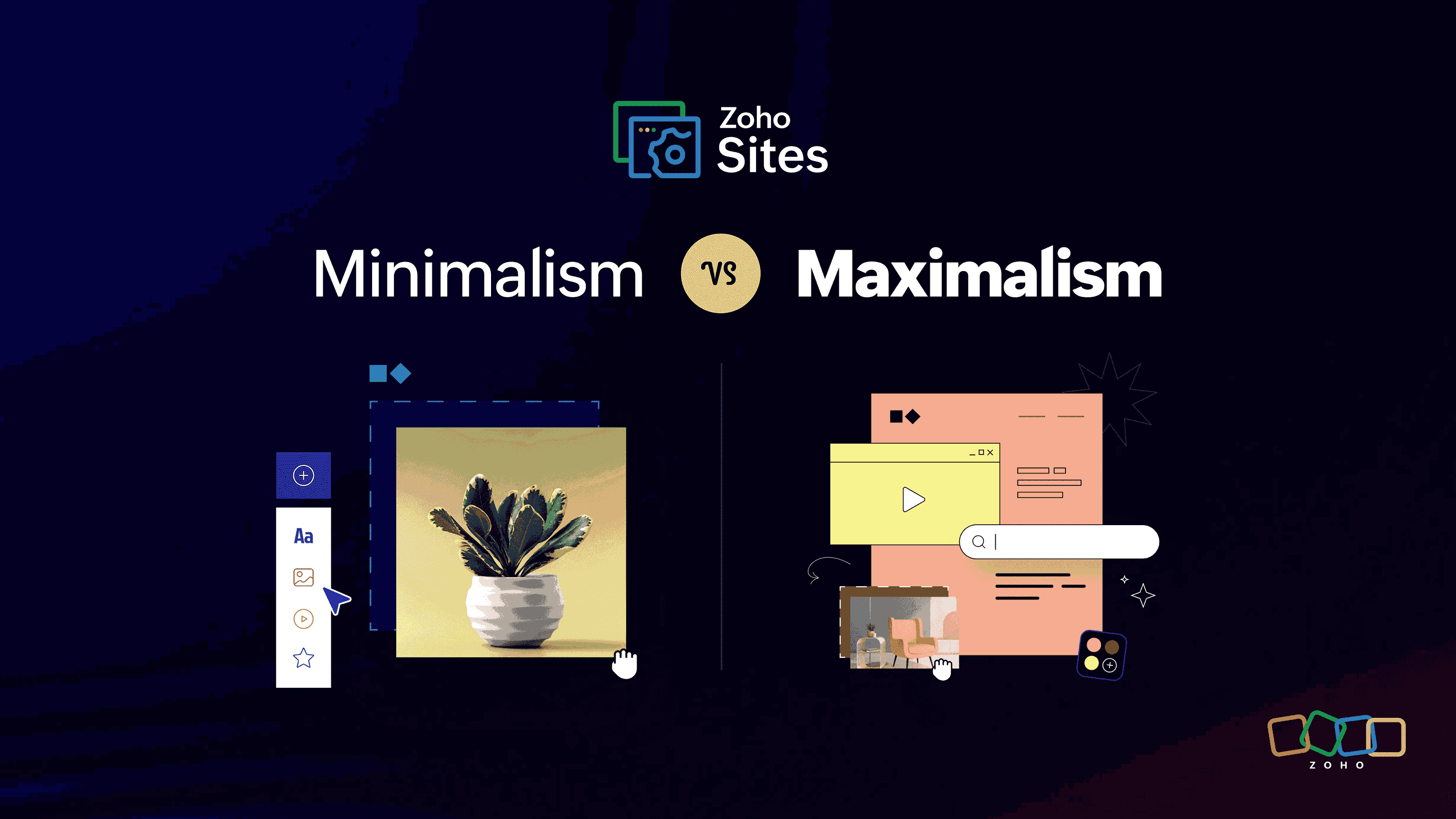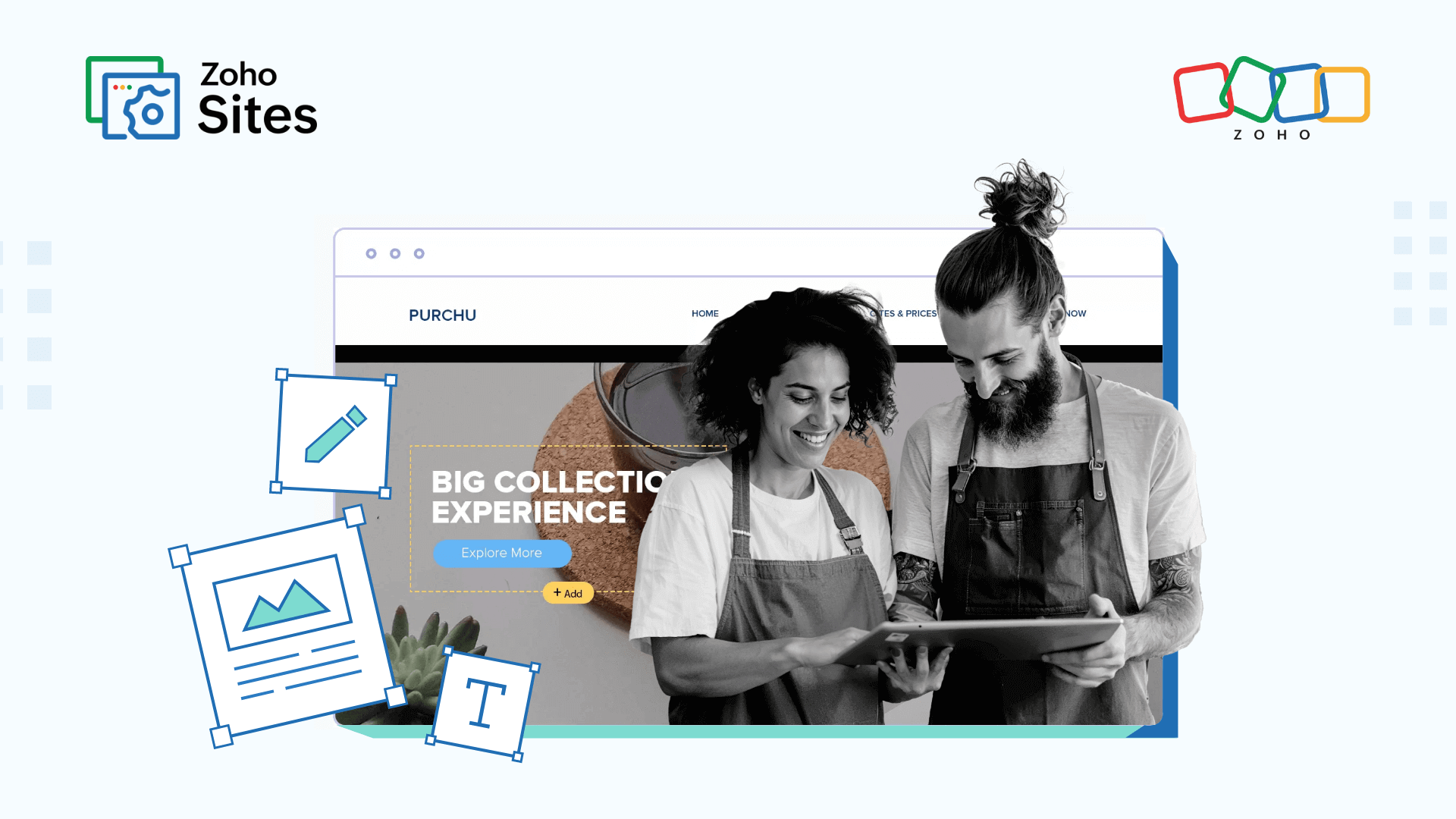Brand storytelling: Tips to inspire, engage, and grow your audience
- Last Updated : November 4, 2025
- 81 Views
- 15 Min Read

Sometimes, brand names become the word for an entire product. We don’t say “make a photocopy,” we say “Xerox it.” It’s not petroleum jelly, it’s Vaseline. It's not a vacuum flask, it's a Thermos.
That’s the power of a compelling brand story. These brands didn’t just sell products they built meaning, emotion, and trust around what they stood for. They became common nouns.
The secret? Storytelling that sticks.

Image source: AI generated
Behind every unforgettable brand is a story that resonates, conveys values, solves real problems, and connects with people on a human level. And no, you don’t need to be a billion-dollar giant to do it; you just need clarity, emotion, and a strong sense of purpose.
In this guide, we’ll break down how to craft a brand story that transforms businesses from “just another option” to the only one they remember.
Ready to create a brand people don’t just buy but believe in? Let’s dive in.
What is a brand story and why does it matter?
According to Harvard Business School, brand storytelling is a strategy where a company uses narratives to communicate its brand identity, values, and message to customers.
A good brand story should be able to stop you in your tracks when you're doom-scrolling the Internet. It shouldn't sell a product—it should share perspective. The voice must feel personal for the story to pull you in, and before you know it, you’re reading every post or watching every video like it’s the next chapter in a book you didn’t know you were waiting to read.
Take Ben & Jerry's, for example. They're not just about deliciously indulgent flavors; they're about two guys in a renovated gas station who created a social mission as sweet as their Chunky Monkey. But have you wondered why they mix in chunks with their ice creams? Because Ben Cohen, the co-founder, can't smell and only relies on texture to enjoy his food. This led to them making their trademark chunky ice creams. Suddenly, buying their ice cream feels like supporting an epic quest for taste and joy, one pint at a time.

Image source: Entrepreneur
Creating a brand story isn't about spinning fairy tales. Your brand's story should include those moments that make people say, "Whoa, I didn’t know that about them!" It should leave your audience wowed as well as inspired. That's how they will build a connection with your brand and eventually become brand loyalists. Bill Bowerman made his iconic waffle shoe soles using his wife’s waffle maker, which was later patented by Nike. When you weave in surprising trivia and relatable quirks, your audience isn’t just buying a product; they’re becoming part of your narrative.
So how do you make a real impact with your brand story? Making an impact is about making people feel the emotions of your brand. Remember, it’s not just about the polished victories but also the delightful disasters that make your brand human. A magnetic brand story is what turns a small bakery into the neighborhood spot where generations gather.
Importance of brand storytelling in marketing
The usual scenario is walking into a store, asking for a vacuum, and getting pointed to "a vacuum." A hair dryer? You're pointed to "any hair dryer." Water bottles? "That aisle."
No story, no specifics. Just bland objects and utterly forgettable interactions.
Now imagine that before you even finish saying "vacuum cleaner", the salesperson doesn't just tell you that Dyson has superior suction power; he weaves a saga about cyclonic technology that separates dust from air. You came in for a simple appliance, yet you're leaving with a narrative so compelling that Dyson's brand storytelling makes you part of the adventure.
It took five years, 5127 prototypes, and was almost sold to the Russians before Dyson became what it is today.

Image source: Walmart
It's not just a sales pitch; it's a masterclass in how to create a brand story that captivates and convinces, turning mundane features into magical experiences.
This is the same reason someone would pick a Peleton over an Echelon or a Bowflex. Peleton wanted to bring the cycling experience to people's homes. With taglines like "Designed for endless ways to move," they sold motivation over machinery.
Before becoming the darlings of social media during the pandemic, Peleton was facing a $300 million lawsuit. With the right strategy, they flipped the script to become status symbols like Apple and Nike.
Creating an impactful brand story
The charm of brand storytelling lies in its ability to create strong connections with the audience. Traditional marketing often says, "Buy Now" while a well-thought brand narrative whispers, "Let’s embark on a journey together". The four pillars to make an impactful narrative are:
Voice: Your brand's unique personality in all types of communication. Is it witty or playful? Authoritative or trustworthy? Bold or rebellious? It's the tone, style, and vocabulary that makes your brand instantly recognizable, even without seeing a logo.
Values: The non-negotiable principles that guide everything you do they're like the Robin to your Batman, always pointing you in the right direction. Whether it's innovation, sustainability, or community, they're the bedrock of your identity. They lay the solid foundation on which your branding and even your marketing can thrive.
Mission: A clear, concise statement that defines what your brand does, who it does it for, and why it does it. It's your brand's core business, its reason for being, and its primary objective in the present moment.
Vision: The ultimate dream, the long-term impact you hope to achieve on a larger scale, often extending beyond just your products or services.
If your brand narrative doesn’t align with your audience’s world, it doesn’t matter how bold or beautiful the visuals are. It simply doesn’t belong, and people can sense that disconnect instantly. Let's look at the 5 elements involved in creating a brand story that sticks and sells.
1. Origin story – The why
The origin story is the driving force behind how the brand came to be. It’s not just the “when” and “where” but the human element, the spark that started it all.
Example: The story of Revant Himatsingka, aka The FoodPharmer, began with a moment of quiet frustration in a grocery aisle. Surrounded by fake “healthy,” “organic,” and “sugar-free” labels, he realized how easy it was for consumers including him to be fooled by clever branding.
2. The hero – Who the story is about
There can be two heroes:
The Founder – Their journey, struggles, and motivations.
The Customer – How they become a hero in the founder’s narrative.
Example: Revant Himatsingka moved from the US to start a health movement in India. By championing clean food labels and exposing harmful ingredients in popular products, he created tools like sugar boards to highlight sugar content. His work caught the government’s attention, leading to its inclusion in school curriculums.

Image source: X
3. The challenge – The conflict
The challenge is the obstacle or problem that the brand aims to solve, framed in a way that resonates emotionally.
Example: Despite receiving no income from awareness content and dealing with legal threats, Revant persisted. His candid framing of these challenges connected deeply with people, including celebrities, positioning him as a national vocal advocate for clean labels.
4. The solution – The brand’s role
Here’s where the brand steps in—not as the hero, but as the guide that enables transformation.
Example: Apart from actively visiting educational institutions to educate about his sugar and oil boards and spread awareness, Revant launched his own protein powder that was free from harmful additives, aligning his product with his advocacy.
5. The transformation – The payoff
The transformation is the result of how lives and communities are better because of the brand.
Example: Through Revant's efforts, consumers are now more aware of what they eat, schools are teaching food literacy, and healthier product choices are entering the market.
Case study: Lush Cosmetics
A Lush store is an explosion of scents, colors, and handmade products. You don't just see soap; you feel a philosophy. That's because Lush has masterfully woven its core values and mission into the fabric of its brand story. Lush didn't just stand out; they disrupted the beauty industry. They didn't follow trends; they created them.
Lush is built on principles like freshness, handmade quality, ethical sourcing, and environmentalism. They are loud and proud about their activism and transparency. Lush doesn't just say they're ethical; they are ethical.
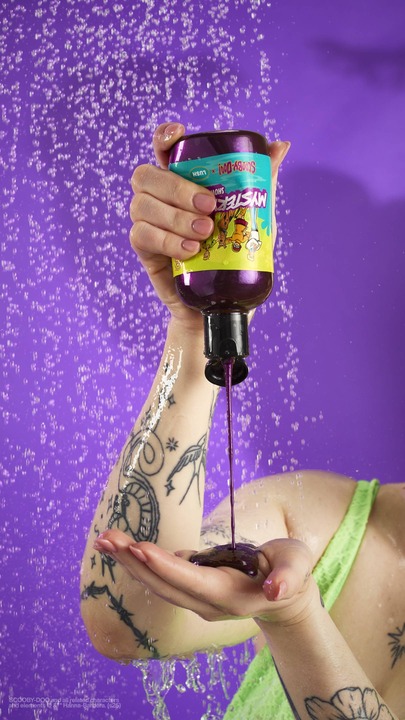
Image source: Lush
Their voice: Lush's voice is irreverent, witty, sometimes provocative, and always honest. They speak like passionate activists. This authentic tone resonated deeply in an industry often perceived as superficial.
Their values: Lush stands for fresh, handcrafted quality. Every product reflects their unwavering opposition to animal testing, something that is non-negotiable to them. They champion ethical sourcing directly from communities and foster fair partnerships. They also embody environmental guardianship, leading with initiatives like naked packaging and fighting plastic waste.

Image source: Lush
Their mission: Their daily purpose is to invent and create effective, innovative cosmetics that are truly fresh and handmade, all while adhering to rigorous ethical standards. It's about empowering consumers to make conscious choices by offering a transparent and kind alternative to conventional beauty products.
Their vision: They made buying a Lush product an act of aligning with their mission. When you bought a Charity Pot, 100% of the price went to grassroots organizations. You weren't just buying lotion; you were directly contributing to animal rights, environmental protection, or human rights. This empowered customers to become a part of the "revolution".
Knowing your target audience
To craft a narrative that truly sticks, it's important to know and understand the people you want to reach out to. Brand owners must find answers to questions like these:
Where are they from?
What do they like?
How do they feel about spending on services and purchases?
What are their pain points?
What desires do they have with brands and products?
What makes their heart sing, their ultimate jam?
How do they really feel about dropping some cash? Are they bargain hunters or ready to splurge?
What's their biggest headache, the one thing that keeps them up at night?
When it comes to brands and products like yours, what's their secret wish, that unfulfilled desire?
If you don’t know your audience’s demographics, pain points, and desires, you’re basically guessing, and guesswork won’t build a solid online presence. This is the stuff that takes your content from “meh” to “where have you been all my life?” territory.
Empathy mapping is how you get inside your audience’s head and heart. What are they thinking, feeling, saying, or doing? When you map that out, your content stops sounding like generic noise and starts sounding like you read their mind. Finally, create audience personas—give your dream customer a name and a whole personality.
Ask the right questions, do a little digging, and suddenly you’re not just making noise—you’re making people feel seen, heard, and maybe even a little obsessed.
Case study: Huda Beauty
Huda Kattan, an Iraqi-American makeup artist and beauty blogger, launched Huda Beauty in 2013. What began as a blog and a YouTube channel soon evolved into a full-blown beauty brand now valued at over $1 billion, with a cult following and a powerful presence in both online and retail spaces.
Huda’s success lies in her obsessive understanding of her audience—primarily young women across the Middle East, South Asia, and global glam lovers who felt unseen by mainstream Western beauty brands.

Image source: Huda Beauty
She identified that:
Her audience wanted high-coverage, long-lasting, bold products.
They valued tutorial-style content that educated, not just sold.
There was a massive gap in inclusive shades, especially for medium to deep skin tones.
They craved authentic reviews, product transparency, and beauty that celebrated glam, not minimalism.
She didn’t just guess what people wanted—she listened, observed, and built her brand around real needs, preferences, and pain points. From launching with false lashes (a highly demanded product within her beauty community) to expanding into bold, full-coverage makeup that celebrated glam looks often overlooked by mainstream brands, every move was guided by audience insight. Her content, product development, and branding all reflected her audience’s voice, making them feel seen, heard, and valued.
That genuine connection transformed followers into loyal customers and a personal brand into a global beauty empire.
Crafting a relatable and authentic brand narrative
Crafting a relatable and authentic brand narrative helps build trust, boost engagement, and stand out in the crowd. The audience is looking for honesty. A strong origin story shows them the why behind your brand, what drove you, what challenged you, and how you got here. Real stories with real impact and zero fluff.
Incorporating authenticity and transparency into brand storytelling
There was a time when perfection was worshipped. Every picture, tagline, and brand narrative was meant to promote a perfect product, made by perfect people, for a near-perfect customer. Size zero was meant to be a common standard; white skin was the norm, and aging was marketed as something to “fight,” making youth the only acceptable form of beauty.
But that is changing. People now want to see the raw and real side. They want to see flaws, behind-the-scenes, blunders, and everything else that makes you look authentic. This relatability factor makes the customer feel seen and understood.
Case study: Live Tinted
Live Tinted understood that millions of people with medium, olive, and deeper skin tones were being overlooked. Deepica Mutyala, Live Tinted's Founder and CEO, knew this because she was the audience. She didn't just create products, she created a community. The brand began as a digital platform focused on under-represented voices in beauty. From there, it evolved into a product line made specifically for melanin-rich skin.
By tapping into real conversations about hyperpigmentation, undertones, and cultural representation, Live Tinted built instant loyalty. It wasn’t selling diversity as a trend—it was living it, breathing it, and formulating for it.

Image source: Live Tinted
Key Strategies
Community-first approach: The brand started as a content platform, gathering insights, stories, and real feedback before launching products.
Solving real skin concerns: Products like the Huestick weren’t just innovative they solved common issues for melanated skin that mainstream brands ignored.
Minimal yet impactful product line: Focused, high-performing essentials instead of cluttered launches.
Social-first storytelling: The brand grew through authentic conversations, not paid hype.
By tackling topics like cultural identity and skin concerns head-on, Live Tinted did more than fill a gap in the market—it sparked a movement. One that made people of color feel seen and included in the beauty industry. They no longer had to blend lighter shades of foundation in the name of makeup.
Using emotional and visual elements in brand storytelling
Brands craft videos to make you feel emotions. They either want you to feel nostalgic about the freshly washed fragrance of linen, crave the creamy mac and cheese that they make, or simply cry over puppies crossing the road, depending on how their brand is placed. I'm sure you felt three different emotions just reading these. That's how emotional elements work in storytelling.
Think of a cold drink that's served in a glass bottle with historical design features—you instantly thought of Coca-Cola, didn't you? And what's the first image that came to your mind? The famous red and white branding. This is the power of using visual elements in your brand narrative.
Case study: Scrub Daddy
Aaron Krause, the founder of Scrub Daddy, never meant to revolutionize dishwashing. He was in fact a mechanic who accidentally damaged the paint while polishing a car. This led him to invent buffing and polishing pads to be used on vehicles. While the product was acquired by 3M, it never made substantial sales.
It was almost a failure until one day he used it to wash dishes and realized that he'd been sitting on a gold mine all this while—the sponge changed texture based on the temperature of water. Their story isn’t just about a cleaning sponge; it’s about making cleaning faster, easier, and surprisingly fun. Their brand addressed relatable pain points:
Sponges get gross and smelly within a few uses.
Difficulty cleaning oddly shaped items.
The dull, joyless nature of scrubbing chores.
He carved on a smiley face, gave it eyes (to hold onto), and suddenly, the sponge had personality, all wrapped in eye-catchingly bright packaging.

Image source: AI generated
It exploded when influencers did comparison videos, showed results, and established that it lasts well over 8 weeks, much above the average yellow sponge.
Scrub Daddy's color palette of bright yellow with contrasting blue or orange accents isn’t random. In color psychology, it means :
Cleanliness and optimism (yellow)
Trust and reliability (blue)
Energy and visibility on shelves (orange)
The Impact:
Over $300 million in retail sales to date.
Became Shark Tank’s most successful product.
Expanded into an entire line of over 20+ cheerful, color-coded cleaning products.
Sold in major retailers like Walmart, Target, and QVC.
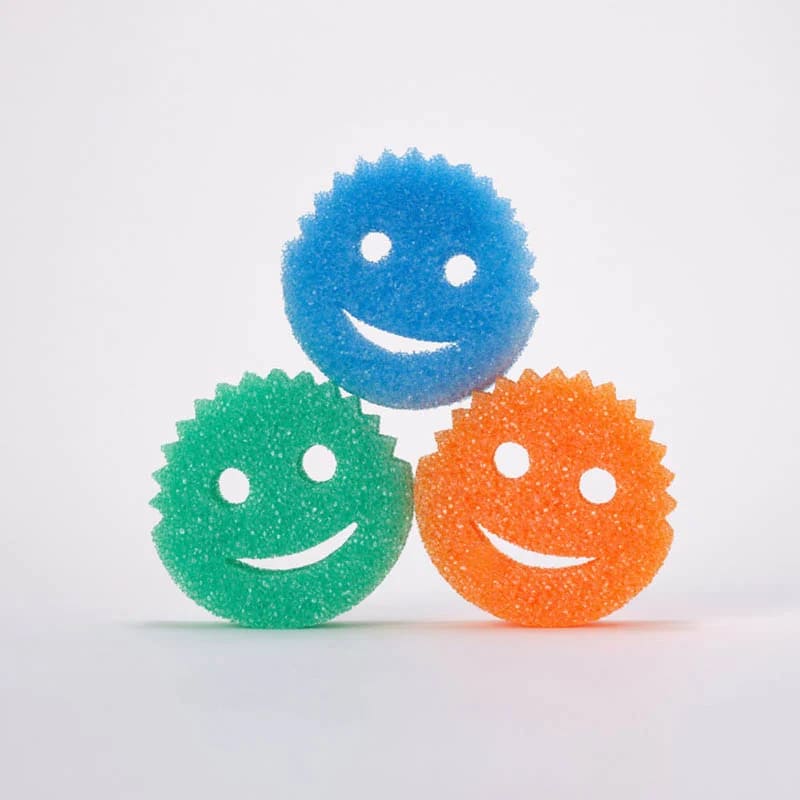
Image source: Scrub Daddy
The minute you see a round sponge with a smile, you know it's Scrub Daddy. Scrub Daddy didn't invent the sponge. With clever design, relatable storytelling, and color psychology, it turned a forgettable household item into a pop culture icon.
Developing a consistent brand voice and message across channels
The voice of a brand conveys its personality, and it has to be consistent and similar across channels. While you can change up the language according to the platform (e.g., Instagram presents content differently than LinkedIn), it's crucial to keep the tone and message in line with your brand narrative.
You can't share a Shakespearean sonnet-like newsletter on one platform while using knock-knock jokes on your social posts. It's confusing, and people will lose interest soon. This will eventually lead to fewer clicks, leads, and conversions. If your brand talks about sustainability, you can't ship products wrapped in plastic. If you advertise about yoga and meditation, you can't collaborate with a brand that promotes fast fashion and consumerism. Inconsistent branding chips away at the story that you worked so hard to build.
Case study: Chamberlain Coffee
Emma Chamerlain didn't wake up one fine day to sell coffee. From awkward espresso runs to DIY iced lattes, Emma made coffee part of her identity. She weaved it into her narrative right from her early videos. When she launched Chamberlain Coffee in 2019, it didn’t feel like a sell-out move—it felt like the logical next step.

Image source: Chamberlain Coffee
Her brand made people feel quirky and honest, all while being chaotic. Isn't that something we all relate to? She wasn't talking about waking up at 4 am, having the perfect morning routine, and then sipping her coffee. She was talking about running late, missing deadlines, getting work done anyway, along with sipping her coffee. That's where she struck the chord with her audience.
Image source: YouTube
Rooted in personality: The brand’s voice is a direct extension of Emma Chamberlain—quirky, self-deprecating, effortlessly cool. It doesn’t feel manufactured because it isn’t.
Same vibe, every channel: Whether you’re reading a product description, watching a TikTok, or scrolling through their Instagram, the tone is always casual, funny, and refreshingly honest.
Copy that talks like you text: No stiff brand-speak. Just real, friendly language that makes you feel like you're chatting with your BFF about your third iced coffee of the day.
Visuals that match the mood: Bold colors, playful animal mascots, and cozy, nostalgic aesthetics all echo the brand’s laid-back, feel-good energy.
Her marketing isn’t accidental. It’s intentional branding done right and proof that when your voice stays consistent, your audience stays close.
Evaluating, evolving, and adapting your brand story over time
Consistency is key, but adaptation is equally important. Evolution is the reason we use washing machines instead of hand washing our clothes, use blenders instead of the good old mortar and pestle, and travel in cars instead of bullock carts. As times change, your business needs to as well.
Building a clothing brand is great, but you'll be setting yourself up for failure if you keep selling outdated designs that people no longer prefer to wear.
Case study: Popflex
Cassey Ho wasn't new to fitness. As a seasoned pilates coach with a successful YouTube following, she was frustrated with the lack of good activewear options that fit well and supported movements. She was fed up with leggings that rolled down during workouts or sports bras that sacrificed comfort for “aesthetic.”
So, she did what any passionate creator would do—she sketched her dream activewear line Popflex entirely by hand.
What was different about Popflex?
Inclusive sizing: Offering XXS to 3X before it became a trend.
Viral designs: Like the “Crisscross Hourglass Legging,” designed to flatter without digging in—born directly from customer feedback.
Functional innovation: Think skorts with actual pockets, adjustable tops, and bags made for both the gym and everyday life.
How did she achieve this?
She shares every single prototype design on social media, inviting feedback before finalizing designs.
She runs polls, reads comments, and even takes criticism head-on publicly and gracefully.
She shifts collections to reflect what women are asking for now from soft loungewear post-2020 to high-performance gear at present.
Her captions are often handwritten and heartfelt, making customers feel like co-creators, not just consumers.
This openness has built a two-way relationship rare in the world of polished, untouchable fitness brands.
The result? In 2024, Popflex had a pinch-me moment when none other than Taylor Swift was spotted wearing their viral skort while playing tennis. Safe to say that sales went through the roof!
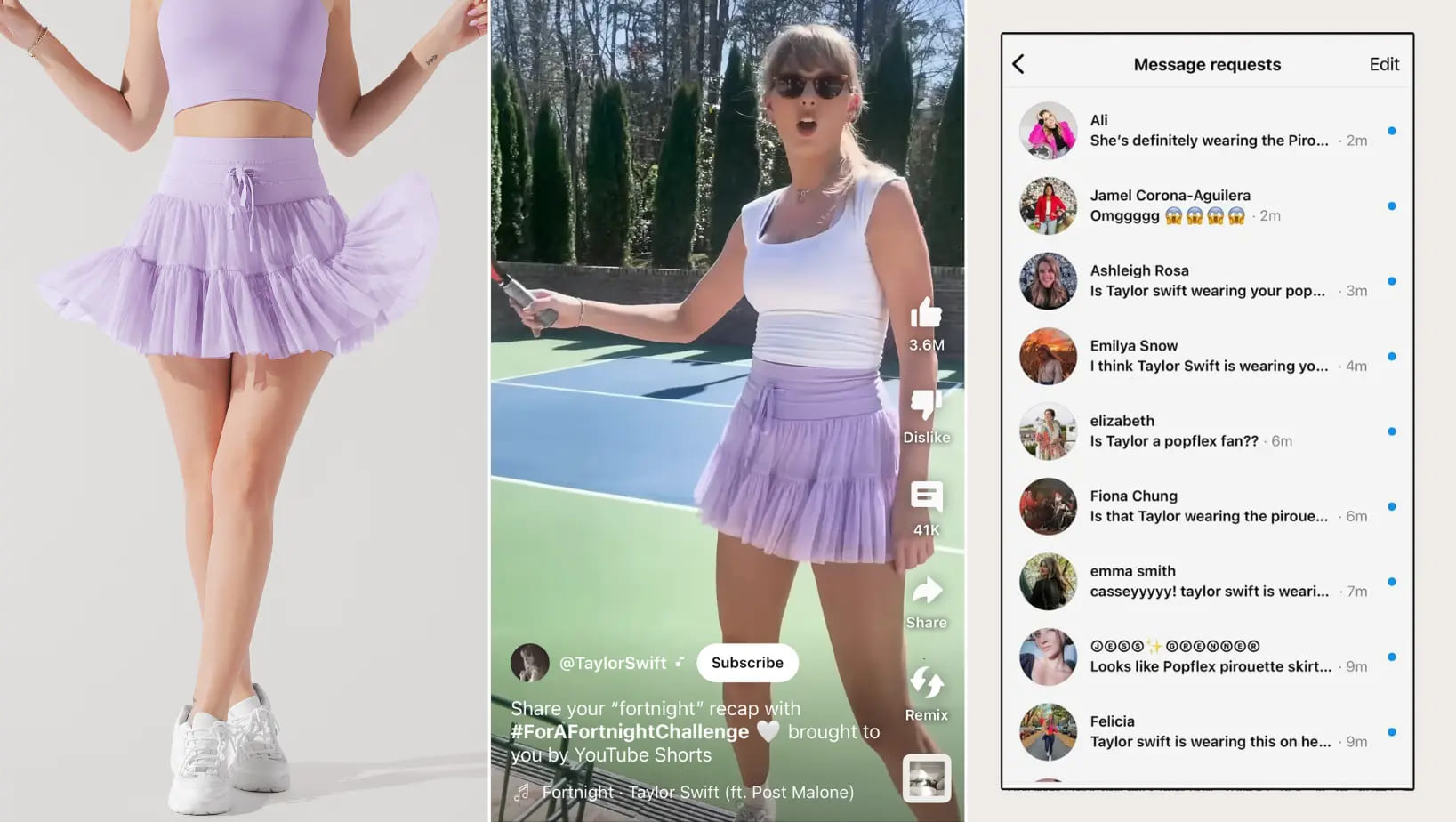
Image source: Retail Brew
Conclusion
Your story doesn’t have to be perfect—it has to be honest. Start messy if you need to. Rewrite it as you grow. So here’s your nudge: carve out a quiet moment, open a fresh page, and ask yourself "What’s the story I want to tell?" Then write it. Not for the algorithm. Not for the trend. But for the people you're meant to reach.


